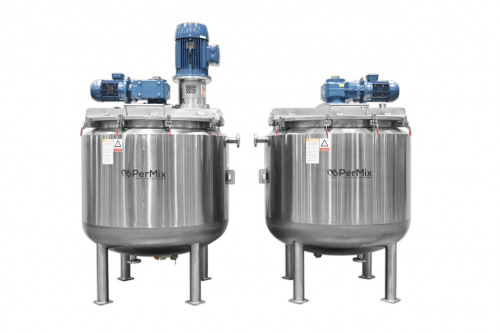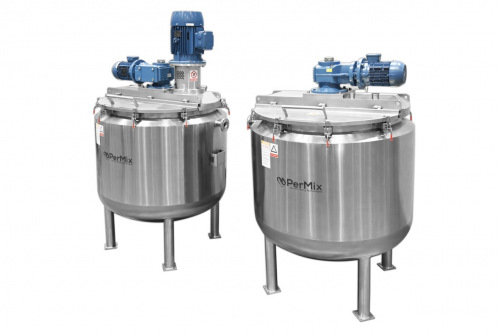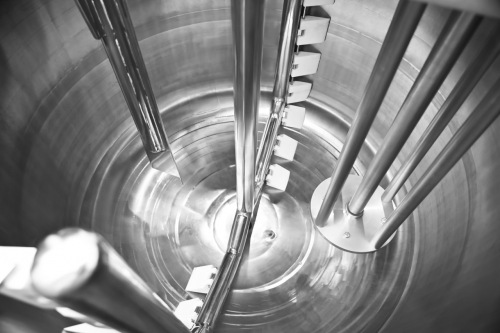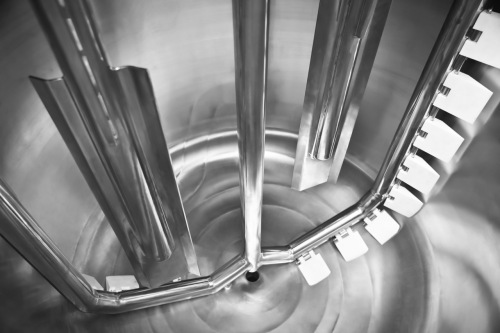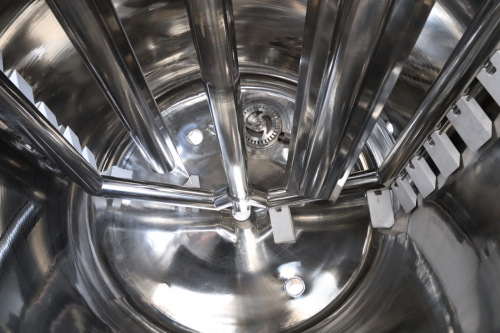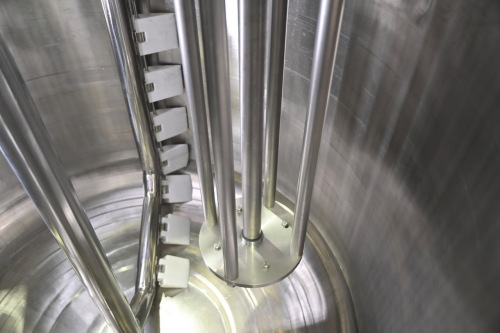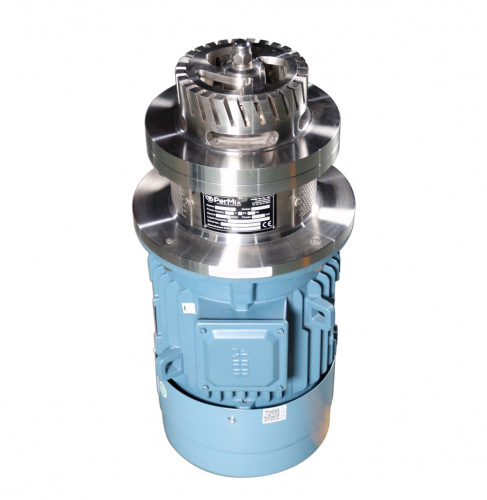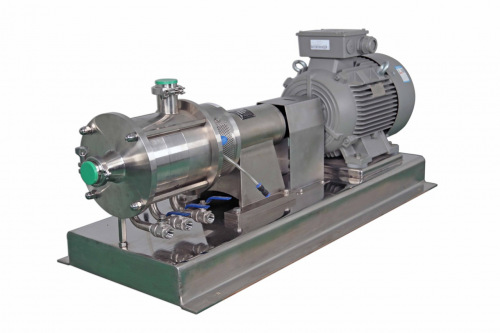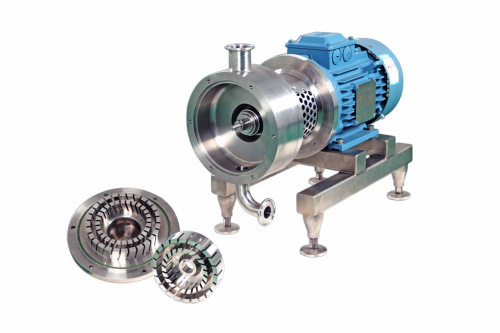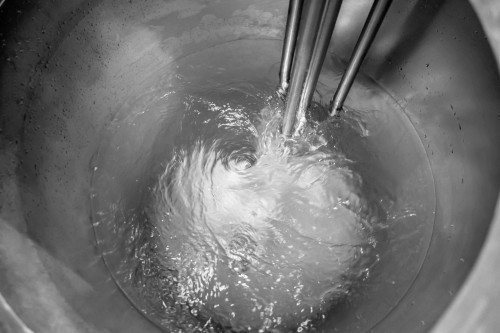Principle of operation:
High shear mixers work with a specially designed stator/rotor working head. When this system is activated, this stator/rotor head is able to pull the solids and liquids around it inward and then push them radially through the stator ports back into the tank.
During this time, solids and liquids are subjected to a grinding and shearing action that is so intense that they deagglomerate, homogenize and disperse within themselves, even though they do not mix through traditional mixing.
There are four steps to explain the working principle:
Step 1. When the rotor is driven by the motor, it rotates at a very high speed of several thousand revolutions per minute. A strong suction is generated in its center, which draws both solids and liquids from the bottom of the tank into the middle zone.
Step 2. Centrifugal force guides the materials to the edge. The materials are subjected to intensive crushing and grinding with a precisely machined clearance between the rotor and stator. There, too, high pressure is created by the build-up of materials, which makes collisions between particles more unusual.
Step 3. Another intense hydraulic shear occurs as materials are forced through holes in the stator at very high speeds. When material particles escape from the stator, they tend to explode into thousands of even smaller ones as the pressure drops rapidly.
Step 4. Fresh materials are continuously drawn into the stator-rotor, maintaining the mixing cycle. Due to the vortex in the tank, materials in each corner of the tank can pass through the stator-rotor system many times, resulting in the formation of fine droplets.
Stator/rotor system
We offer two types of stator and rotor systems: V and K, and both have several subtypes. The reason there are so many stator and rotor system designs is to offer our customers more choice so they can choose the most suitable one for their specific liquids and solids.
Installation and commissioning:
In a batch process, the mixer is immersed in the liquid. There are many methods for installing a batch mixer. It can be lifted by means of a jack (hydraulic or electric) or can be mounted with a flange on the top, side or bottom of the tank. In the case of a vacuum or pressure vessel, the mixer must be equipped with a mechanical shaft seal.
– Mounted from the top, open tank
These mixers are used in an open tank, that is, a tank with normal pressure. These are top entry mixers that can be installed on a lifting stand or directly on the tank using a flange or traverse. The coupling between the motor and the shaft is optional to ensure low noise and stable operation.
– Mounted from the top, closed tank
These high-speed top entry mixers are equipped with a mechanical seal that allows them to operate in a pressure or vacuum vessel. Single or double seals are available.
– Side mounting
Side entry mixers are very useful when the tank is deep but narrow, or when the top space of the vessel is limited for top entry mixers.
– Bottom assembly
Bottom mixers are ideal when the liquid level in the tank may be very low during operation or when there is very little space above or around the tank for top or side mounting. Moreover, in the case of PERMIX bottom mixers, strong vortices and aeration are significantly reduced.
Apps:
High shear mixers are widely used in various industries at various stages of product processing. They are very efficient, which saves a lot of energy and time compared to traditional mixing methods.
– Food and beverages
Milk powder, Salad dressing, Mayonnaise, Ice cream, Cheese, Yogurt, Fruit juice
– Pharmaceutical and biological products
Drug Synthesis, Vaccine, Lipid Emulsion, Injection Suspension, Veterinary, Extraction
cells
– Cosmetics and products for daily care
Detergent, Body gel, Shampoo, Cream, Lotion, Toothpaste, Soap
Specification:
Top mounted mixer:
| Model | Engine power, kW | RPM, @50Hz | Maximum capacity, L | Shaft length, mm | |
| @1 cPs | @3,000 cPs | ||||
| PS-X/080 | 1.5 | 3000 | 50 | 20 | 350 |
| PS-X/100 | 2.2 | 100 | 50 | 600 | |
| PS-X/120 | 4 | 300 | 150 | 700 | |
| PS-X/140 | 7.5 | 800 | 500 | 800 | |
| PS-X/160 | 11 | 1500 | 750 | 820 | |
| PS-X/180 | 18.5 | 2000 | 1000 | 1100 | |
| PS-X/200 | 22 | 1500 | 4000 | 2000 | 1150 |
| PS-X/220 | 30 | 5000 | 2500 | 1200 | |
| PS-X/240 | 37 | 6500 | 3200 | 1300 | |
| PS-X/270 | 55 | 10000 | 5000 | 1500 | |
| PS-X/290 | 75 | 12000 | 6000 | 1550 | |
| PS-X/300 | 90 | 15000 | 7500 | 1600 | |
1) PS-C, PS-D, PS-M share the same specifications.
2) Actual liquid capacity will vary depending on the liquid type and different stator rotor system.
3) PerMix offers bigger capacity according to customer requests.
4) PerMix reserves the right to modify the design without notice.
Bottom mounted mixer:
| Model | Engine power, kW | RPM, @50Hz | Maximum capacity, L | Shaft length, mm | |
| @1 cPs | @3,000 cPs | ||||
| PS-B/80 | 1.5 | 3000 | 50 | 20 | 80 |
| PS-B/100 | 2.2 | 100 | 50 | 100 | |
| PS-B/120 | 4 | 300 | 150 | 150 | |
| PS-B/140 | 7.5 | 1000 | 500 | 150 | |
| PS-B/160 | 11 | 1500 | 750 | 150 | |
| PS-B/180 | 18.5 | 2000 | 1000 | 180 | |
| PS-B/200 | 22 | 4000 | 2000 | 180 | |
| PS-B/220 | 30 | 5000 | 2500 | 190 | |
| PS-B/240 | 37 | 1500 | 6500 | 3200 | 200 |
| PS-B/270 | 55 | 10000 | 5000 | 210 | |
| PS-B/290 | 75 | 12000 | 6000 | 210 | |
1) Actual liquid capacity will vary depending on the type of liquid and different stator-rotor systems.
2) PerMix offers larger capacity mixers according to customers' requests.
3) PerMix reserves the right to modify the design without notice.



